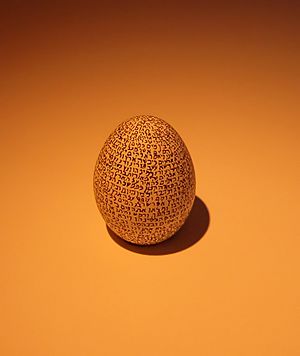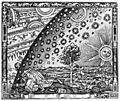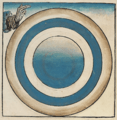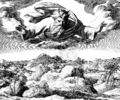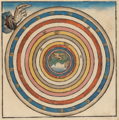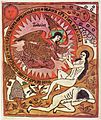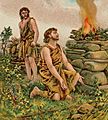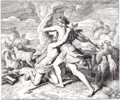Bereshit (parashah) facts for kids
Bereshit (pronounced Beh-reh-SHEET) is a special Hebrew word. It means "in the beginning." It's the very first word in the Torah, which is a holy book for Jewish people. Bereshit is also the name of the first part of the Torah that Jewish communities read each year. It tells amazing stories about how the world began.
This part of the Torah is read by Jewish people on the first Sabbath (which is like a holy day of rest) after a holiday called Simchat Torah. This usually happens in October.
Contents
The Story of Creation
The book of Bereshit begins with the incredible story of how God created everything.
God Creates the World
The story starts with God creating the heavens and the world. God made light and darkness, the sky, and the land. God also created all the plants, trees, and every kind of animal. Each day, God created something new and wonderful.
Adam, Eve, and the Garden of Eden
After creating the world, God created the first two humans. Their names were Adam and Eve. God placed them in a beautiful place called the Garden of Eden. It was a perfect paradise with plenty of food and beautiful scenery.
The Forbidden Fruit
God gave Adam and Eve one rule: they could eat from any tree in the garden, except for one. This was the tree of the knowledge of good and evil. God told them that if they ate from this tree, there would be serious consequences.
Disobedience and Consequences
One day, a serpent talked to Eve. The serpent convinced her that eating the forbidden fruit would make her wise. Eve ate the fruit, and then she gave some to Adam, and he ate it too. Because they disobeyed God, they were sent out of the beautiful Garden of Eden. This was a big change for them.
The First Family and Their Challenges
After leaving the Garden of Eden, Adam and Eve had children. Their family grew, but they also faced new challenges.
Cain and Abel
Adam and Eve had two sons named Cain and Abel. Cain was a farmer, and Abel was a shepherd. Both brothers brought offerings to God. God was pleased with Abel's offering, but not with Cain's. This made Cain very jealous and angry. Sadly, because of his anger, Cain harmed his brother Abel. This was a very sad event for the first family.
Growing Population and God's Sadness
Adam and Eve had more children, and their descendants populated the Earth. However, as more and more people lived on Earth, many of them started doing bad things. They were not kind to each other, and the world became full of violence. God saw how people were behaving and felt very sad.
Noah and the Flood
Because of the widespread bad behavior, God decided to bring a great flood to the Earth. This flood would wash away all the wickedness. However, there was one person who was good and found favor with God. His name was Noah. God chose Noah and his family to survive the flood. This part of the story sets the stage for the next big event in the Torah.
Bereshit in the Torah Scroll
The part of the Torah called Bereshit is quite long. It has 7,235 Hebrew letters and 1,931 Hebrew words. It is made up of 146 verses. When written in a special scroll called a Sefer Torah, it takes up 241 lines. Jewish people read this section over several weeks as part of their yearly cycle of Torah reading.
Images for kids
-
The Fall of the Rebel Angels by Hieronymus Bosch is based on Genesis 6:1–4
-
The Expulsion from Eden (woodcut by Julius Schnorr von Carolsfeld from the 1860 Die Bibel in Bildern)
-
Rabbi Jonah taught not to investigate what was before (illustration from Camille Flammarion's 1888 L'atmosphère: météorologie populaire)
-
the Hebrew letter bet
-
The Third Day of Creation (woodcut by Julius Schnorr von Carolsfeld from the 1860 Die Bibel in Bildern)
-
The Sabbath (woodcut by Julius Schnorr von Carolsfeld from the 1860 Die Bibel in Bildern)
-
The Blessing of the Seventh Day (13th-century mosaic in St Mark's Basilica)
-
The Story of Cain and Abel (illustration from a Bible card published 1906 by the Providence Lithograph Company)
-
Naamah, the Teacher, with Her Half-brother Jubal, a Father of Music (14th-century marble bas relief at Orvieto Cathedral)
-
Building the Ark (watercolor circa 1896–1902 by James Tissot)


